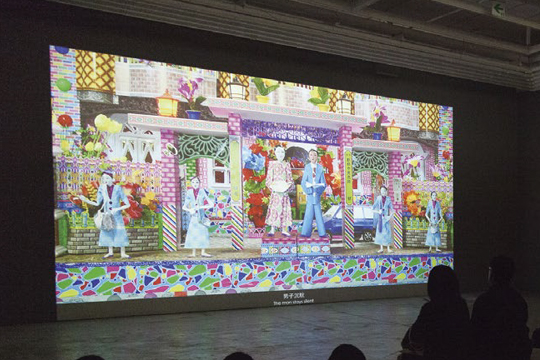SU YU-HSIEN: HUA-SHAN-QIANG
| July 30, 2013 | Post In LEAP 21

In 1989, two wildfires raged through Taiwanese society, leaving devastation and pain in their paths, while they continue burning to this day. In Su Yu-Hsien’s solo exhibition at TKG+ gallery, “Hua-shan-qiang,” these furious flames are refracted through the exhibition—photographs, a narrative video, and on-site installations—and the result is a beautiful yet tragic world rooted in Su’s observations of local reality.
The only video on display serves as a link between the burnt and collapsed paper-constructed structures that occupy the main exhibition space, and the groups of photograph portraits. The story is told from a third-person perspective and includes highly theatrical dialogue spoken in Taiwanese. Using a symmetric narrative structure where the opening and ending scenes mirror each other, Su has constructed a wondrous travelogue of folk customs, mixing fact and fiction. The video tells a story that takes place under the colorful and ornate gables of a Taiwanese house in the Minnan style, which Su has constructed entirely from paper. The audience sees a familiar grouping, the obedient and dedicated servants who accompany the deceased in his afterlife. They appear as smooth-skinned plastic dolls with simply drawn facial features, and have been transported to the underworld via the flames of a funeral pyre.
The group is waiting for the arrival of boats that transport the deceased into the world of the dead. They are: a youthful couple, the traditional golden boy and jade girl; a funerary band sounding the suona; male and female masters of ceremonies; a pair of male and female servants for the deceased; pillar bearers that hold up the house’s beams; faceless litter porters, a driver, and bodyguards; and the ogres responsible for delivering the deceased once the boat arrives. (1) Each one has a specific occupation and particular station. Standing at the transition point between life and death, they are intently waiting for the deceased, whose arrival signals the start of their collective journey. The story begins when a pillar bearer accidentally falls asleep, which causes intense concern in the rest of the group, all of whom remain standing dutifully at their posts. They are worried that since he has fallen asleep, who could hold up the beams to keep the roof from falling down? In the midst of their great agony, the deceased, who died from self-immolation and is now just a spirit-body, steps into the exchange station, flames in tow. His delicate features have been carefully painted with a calligraphy brush. Without a word he accepts the duty of shouldering the sleepy pillar bearer’s burden. He now joins the waiting retinue of after-life servants inside this gloriously appointed house of the underworld, wondering how many more years and months they must wait before their admittance into the “Western Paradise.”
In his previous works, Su Yu-Hsien has always been able to analogize Western creative language through acute yet humorous observations. An example is his contribution to the Venice Biennale in 2011, “The Heard and Unheard,” which displayed a soundscape of Taiwanese society that crossed classes and multiple ethnic identities. In this solo exhibition, Su uses folkloristic images to reflect the intermingling of reality and fiction that bears on conceptions of life and death. The video is an incisive metaphor for Taiwanese politics and the island’s uncertain political identity. The two pillar bearers seem to represent government and populace, such that when the left pillar bearer falls asleep, the entire group grows anxious, even after the flame-engulfed spirit-body shoulders the load. Stranded between worlds, the group can only hope that their journey will soon end, while straining to remember a melody that they can’t hear, “Do Do Mi Mi So So Mi Re.”
Note:
1. In traditional Taiwanese temple architecture, the han-fan, or pillar bearer, is an ornamental addition to the temple walls’ supporting structure. It is a figurine that props up the dougong, interlocking wooden brackets, which allow the load-bearing columns to connect to the roof. Legend has it that during the Dutch occupation, Taiwanese people expressed their resentments through the architecture of the temples, sculpting figures that resembled the Dutch to forever hold up the heavy roofs. An alternative explanation originates from the same period, which credits the han-fan to Taiwanese admiration for the tall and sturdy physique of Dutch sailors. The builders then began making Dutch-looking figures to hold up the dougong, in the hopes that the temples will withstand the test of time. The pillar bearers in Su’s work were shown as having Asian faces.

